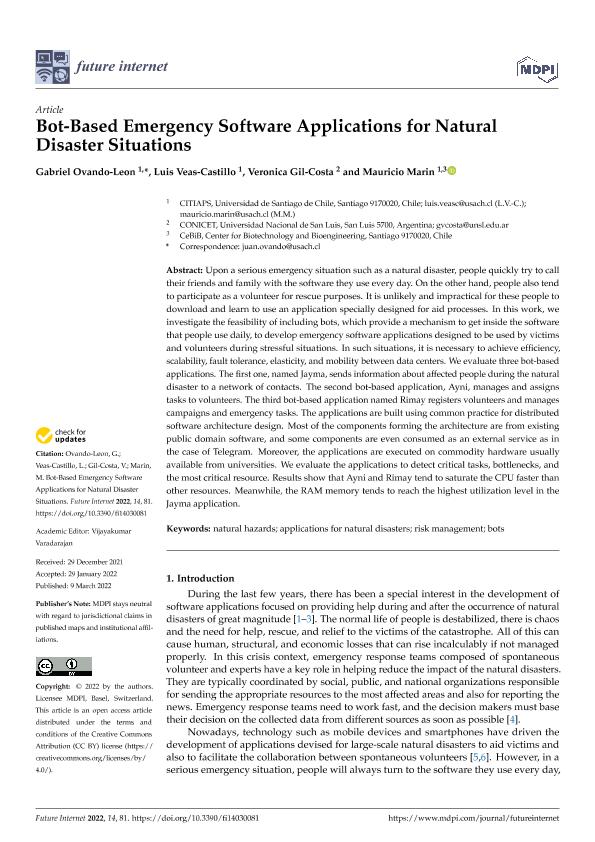Mostrar el registro sencillo del ítem
dc.contributor.author
Ovando Leon, Gabriel
dc.contributor.author
Veas Castillo, Luis
dc.contributor.author
Gil Costa, Graciela Verónica

dc.contributor.author
Marin, Mauricio
dc.date.available
2023-07-06T17:49:22Z
dc.date.issued
2022-03
dc.identifier.citation
Ovando Leon, Gabriel; Veas Castillo, Luis; Gil Costa, Graciela Verónica; Marin, Mauricio; Bot-Based Emergency Software Applications for Natural Disaster Situations; MDPI; Future Internet; 14; 3; 3-2022; 1-22
dc.identifier.issn
1999-5903
dc.identifier.uri
http://hdl.handle.net/11336/202639
dc.description.abstract
Upon a serious emergency situation such as a natural disaster, people quickly try to call their friends and family with the software they use every day. On the other hand, people also tend to participate as a volunteer for rescue purposes. It is unlikely and impractical for these people to download and learn to use an application specially designed for aid processes. In this work, we investigate the feasibility of including bots, which provide a mechanism to get inside the software that people use daily, to develop emergency software applications designed to be used by victims and volunteers during stressful situations. In such situations, it is necessary to achieve efficiency, scalability, fault tolerance, elasticity, and mobility between data centers. We evaluate three bot-based applications. The first one, named Jayma, sends information about affected people during the natural disaster to a network of contacts. The second bot-based application, Ayni, manages and assigns tasks to volunteers. The third bot-based application named Rimay registers volunteers and manages campaigns and emergency tasks. The applications are built using common practice for distributed software architecture design. Most of the components forming the architecture are from existing public domain software, and some components are even consumed as an external service as in the case of Telegram. Moreover, the applications are executed on commodity hardware usually available from universities. We evaluate the applications to detect critical tasks, bottlenecks, and the most critical resource. Results show that Ayni and Rimay tend to saturate the CPU faster than other resources. Meanwhile, the RAM memory tends to reach the highest utilization level in the Jayma application.
dc.format
application/pdf
dc.language.iso
eng
dc.publisher
MDPI
dc.rights
info:eu-repo/semantics/openAccess
dc.rights.uri
https://creativecommons.org/licenses/by/2.5/ar/
dc.subject
APPLICATIONS FOR NATURAL DISASTERS
dc.subject
BOTS
dc.subject
NATURAL HAZARDS
dc.subject
RISK MANAGEMENT
dc.subject.classification
Ciencias de la Computación

dc.subject.classification
Ciencias de la Computación e Información

dc.subject.classification
CIENCIAS NATURALES Y EXACTAS

dc.title
Bot-Based Emergency Software Applications for Natural Disaster Situations
dc.type
info:eu-repo/semantics/article
dc.type
info:ar-repo/semantics/artículo
dc.type
info:eu-repo/semantics/publishedVersion
dc.date.updated
2023-06-28T16:53:58Z
dc.journal.volume
14
dc.journal.number
3
dc.journal.pagination
1-22
dc.journal.pais
Alemania

dc.description.fil
Fil: Ovando Leon, Gabriel. Universidad de Santiago de Chile; Chile
dc.description.fil
Fil: Veas Castillo, Luis. Universidad de Santiago de Chile; Chile
dc.description.fil
Fil: Gil Costa, Graciela Verónica. Universidad Nacional de San Luis; Argentina. Consejo Nacional de Investigaciones Científicas y Técnicas. Centro Científico Tecnológico Conicet - San Luis; Argentina
dc.description.fil
Fil: Marin, Mauricio. Universidad de Santiago de Chile; Chile
dc.journal.title
Future Internet
dc.relation.alternativeid
info:eu-repo/semantics/altIdentifier/doi/http://dx.doi.org/10.3390/fi14030081
Archivos asociados
